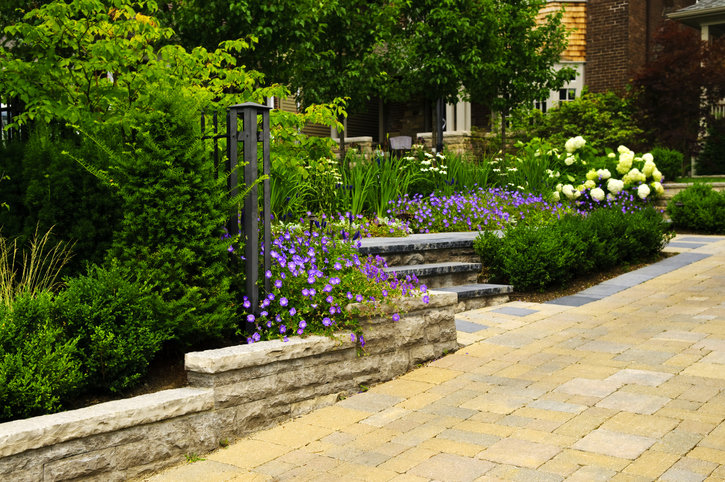Suppose you plan on installing a retaining wall on your property. In that case, it is essential to understand the purpose of a retaining wall and all the necessary features it needs to have to ensure it functions properly and lasts for a long time.
What is the Purpose of a Retaining Wall?
A retaining wall is used to hold back dirt that would otherwise collapse or erode without the wall. If you have a yard that has a steep incline or one that slopes down, you can make the ground level using retaining walls.
They can be used to form garden beds or a terraced walkway to make steep or sloped spaces functional. Additionally, they can be built along with fencing to help make any steep drops on the property safer.
 Retaining walls can be made from a variety of materials, including:
Retaining walls can be made from a variety of materials, including:
- paver blocks
- brick
- stone
- wood
- masonry
- concrete
Does My Retaining Wall Need a Footing?
Yes, every retaining wall requires a footing, but the type of footing it requires will depend on the material used, the design, as well as the height and weight of the wall.
What Type of Footing Does My Retaining Wall Need?
For large masonry retaining walls built from concrete, cement, brick, or cinder blocks, you will require a concrete footing. Solid walls like masonry walls can’t bend or flex without cracking, so they require a durable base to hold them together.
If you plan to build your retaining wall out of loose stone, stacked stone, wood, or bricks without any mortar, you will need a compacted stone footing. Since these materials can flex a little, they do not need a solid base.
The type of footing that you use for your retaining wall will depend on the height of the wall, the amount of soil it is retaining, weather in your area, water, soil condition, and where the wall will be built.
Footing and proper drainage are crucial when building a retaining wall. A footing is required because if the ground shifts below the wall, the wall will shift too and could collapse. Drainage keeps the water pressure from building up underneath and behind that wall, so it doesn’t collapse.
Common Retaining Wall Types and Their Footings
Cinder Block Retaining Wall
When we build a retaining wall from cinder blocks, they are a solid masonry wall since we join the blocks together with mortar. They are stacked vertically rather than angling back into the soil and are built on top of a solid concrete footing rather than gravel.
Brick Retaining Wall
Just like the cinder block wall, a brick wall is joined together using mortar, creating a solid masonry wall. Same as the cinder block wall, the bricks are stacked vertically and are not angled back against the soil. We build brick retaining walls directly on top of the concrete footing rather than gravel. Since it is one solid wall, it can’t flex, so it needs a stable foundation to support it and prevent shifting and cracking.
Large Stone Retaining Wall
We can use large natural stones to build a retaining wall. Because of their large size and weight, they are a great material for holding back soil. We don’t connect these stones together with mortar, leaving them room to shift with the weight of the dirt and pressure from the water. We build this type of wall on top of a gravel footing.
Stone and Mortar Retaining Wall
We use real stone and mortar to create this type of retaining wall. Since it is all permanently connected, it can’t flex and must be built on a concrete footing. Since they are built vertically, the solid concrete footing will help the wall resist the pressure of the soil.
Stacked Paver Block Retaining Wall
To create this type of wall, we will use paver stones of various sizes to stack and build your retaining wall. Rather than using mortar, we install the blocks in a secure pattern and use masonry glue that has more flex than cement. We will build this type of wall on a gravel footing for good drainage.
Timber Retaining Wall
These types of retaining walls can be built horizontally or vertically, depending on your desired look. We will use a compacted gravel footing to ensure proper support and drainage.
Retaining Walls and the Importance of Footings
In summary, retaining walls do need a footing to ensure they are structurally sound and have proper drainage to prevent cracking or collapse. Without a footing, the ground beneath the retaining wall can shift, which can cause the wall to shift as well, leading to cracking or collapse. Drainage is also crucial because it helps to alleviate the pressure created by the water under and behind the wall, which can also cause failure or collapse of the retaining wall.
To learn more about retaining walls and how they can enhance your property, contact A&N Lawn Service today!
